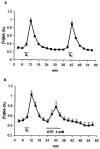Local regulation of [(3)H]-noradrenaline release from the isolated guinea-pig right atrium by P(2X)-receptors located on axon terminals
- PMID: 11139458
- PMCID: PMC1572515
- DOI: 10.1038/sj.bjp.0703757
Local regulation of [(3)H]-noradrenaline release from the isolated guinea-pig right atrium by P(2X)-receptors located on axon terminals
Abstract
In this study the regulation of cardiac sympathetic outflow by presynaptic P(2X) receptor-gated ion channels was examined. ATP (30 microM - 1 mM) and other P2-receptor agonists elicited [(3)H]-noradrenaline ([(3)H]-NA) outflow from the isolated guinea-pig right atrium with the potency order of ATP>2-methyl-thioATP>alpha,beta-methylene-ATP=ADP, whereas ss, gamma-methylene-L-ATP was inactive. Ca(2+)-free conditions abolished both electrical field stimulation (EFS)- and ATP-evoked release of tritium. Unlike from EFS-induced outflow, ATP-induced [(3)H]-NA outflow was not reduced by omega-Conotoxin-GVIA (100 nM), Cd(2+) (100 microM) and tetrodotoxin (1 microM). The rapid extracellular decomposition of ATP was revealed by HPLC analysis. However, the effect of ATP to promote [(3)H]-NA release was not prevented by 8-cyclopentyl-1,3-dipropylxanthine (DPCPX, 250 nM), 3, 7-dimethyl-1-propargylxanthine (DMPX, 250 nM), or by reactive blue 2 (RB2, 10 microM), antagonists of A(1)-, A(2)- and inhibitory P(2) receptors. Zn(2+) (50 microM), the P(2X)-receptor modulator potentiated, and P(2X) receptor antagonists, i.e. suramin (300 microM), pyridoxal-phosphate-6-azophenyl-2',4'-disulphonic acid (PPADS, 30 microM) and 2'-o-(trinitrophenyl)-adenosine 5'-triphosphate (TNP-ATP, 30 microM) antagonized the ATP (1 mM)-evoked response. RT - PCR study revealed the expression of P(2X2) and P(2X3) receptor mRNAs in guinea-pig superior cervical ganglion. PPADS (30 microM) significantly reduced the EFS-induced [(3)H]-NA outflow in the presence DPCPX (250 nM) and RB2 (10 microM). In summary a P(2X)-type purinoceptor regulates noradrenaline release from the isolated right atrium of the guinea-pig. The pharmacological profile of the receptor resemble to homo-oligomeric P(2X3) or hetero-oligomeric P(2X2)/P(2X3) complexes, and provide a new target to intervene on sympathetic neuroeffector transmission at the presynaptic site.
Figures







References
-
- AUSUBEL F.M., BRENT R., KINGTON R.E., MOORE D.D., SEIDMAN J.G., SMITH J.A., STRUHL K., CHANDA V.B.Removal of contaminating DNA Current Protocols in Molecular Biology 1988New York: John Wiley & Sons; edsCh. 4.1.4
-
- BOARDER M.R., HOURANI S.M. The regulation of vascular function by P2 receptors: multiple sites and multiple receptors. Trends Pharmacol. Sci. 1988;19:99–107. - PubMed
-
- BORST M.M., SCHRADER J. Adenine nucleotide release from isolated perfused guinea-pig hearts and extracellular formation of adenosine. Circ. Res. 1991;68:797–806. - PubMed
-
- BRAKE A.J., WAGENBACH M.J., JULIUS D. New structural motif for ligand-gated ion channels defined by an ionotropic ATP receptor. Nature. 1994;371:519–523. - PubMed
Publication types
MeSH terms
Substances
LinkOut - more resources
Full Text Sources
Other Literature Sources
Miscellaneous

